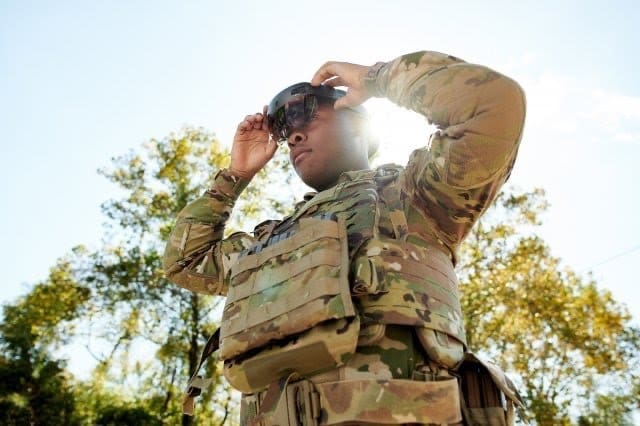ARLINGTON, Va. — The Army has saved about $1.2 billion over the past year using a process called “category management” for purchasing goods and services, a top acquisition official said, adding those savings will be redirected toward modernizing the force.

“This is one of the ways we’re funding the Army’s priorities,” said Rebecca Weirick, executive director of services acquisition in the Office of the Deputy Assistant Secretary of the Army for Procurement. She spoke Wednesday as part of a panel at the Association of the U.S. Army’s “Hot Topics” forum on Army acquisition and contracting.
The panel, titled “Revolutionizing Industrial Age Thinking with Category Management,” pointed out that the concept is a relatively new one for the Defense Department and borrows best practices from the private sector.
A new course, titled “Contracting Efficiencies,” will debut early next year at the Army Logistics University to teach category management concepts to non-acquisition personnel, Weirick said. While the pilot course will be taught at ALU on Fort Lee, Virginia, the curriculum is being put together by the Army’s Office of Business Transformation at the Pentagon.
Under category management, the Army divides purchases into 19 categories, said James H. Lewis, panel chair, who also works in the Army’s procurement office.
Ten of the 19 categories are “common” categories used by all federal agencies, he said, like “professional services” or “security and protection.” The other nine are DOD-centric such as “weapons and ammunition, electronic and communication equipment, or research and development.”
Category management aligns purchases into groups of similar or related products in order to gain efficiencies and save money, Lewis said. The key is a “robust market intelligence capability,” he added.
Sometimes it’s smarter to use a small business, depending on the commodity being purchased, because the overheads are so much lower, Weirick said. Other times it’s smarter to use a large business and buy in bulk, she added. Category management has provided the ability to discern the best acquisition approach using data-driven decision making, she explained.
Weirick gave another example of how analyzing the market data can save money. The 2018 data showed that 26% of the Army’s information technology equipment purchased in the last weeks of the fiscal year were generally more expensive than purchases made outside of this period. This represents a loss in Army buying power. Reducing fourth-quarter purchases to only mission-essential requirements will yield a potential annual savings of about $10 million. This may not seem like much when compared to the defense budget, she said, but all these savings initiatives add up.
The Army began implementing category management last year, she said. The Air Force had already been doing it for a couple of years, so the Army was able to take advantage of data the Air Force had collected, she explained.
While the Army leveraged work the Air Force had already done, the Army took a bit of a different tack, Weirick said. “I’d say it’s sort of like a pincher move,” she added — strong leadership emphasis from the top empowers the teams executing the work to think and do business differently, which creates the momentum for real change.
The secretary of the Army directed implementation of category management, and assigned the under secretary the role of senior official responsible for category management within the Army.
The under secretary named co-category managers at the three- and four-star level both at the major commands, and in the Pentagon. Those same individuals are also responsible for approving budgets, she said.
The Army has set a goal of saving 5% year over year using category management and will reinvest those funds in higher Army priorities, Weirick said.
Steve Benson, director of category management for the DOD Office of the Chief Management Officer, said for every dollar the department has invested in category management, it has realized a return of $160 for a ratio of 1:160.


Do we need to apply the rule of three here?
Seriously though, good work. That will be a sweet bullet on someone’s resume.
Good luck on getting units to stop spending their remaining money in the 4th quarter. This has been a staple of Army money management since time immemorial. If you don’t spend this year’s budget, you might get less next year!
That is something that really needs to change. Units should not be punished because they were fiscally responsible that year. It encourages waste and its why we end up with new office furniture every year and not enough funds to send people to NCOES. Talking specifically about the NG here.
That’s not applicable to this program or article.
Not applicable but relevant.
It literally says so in the article:
“Weirick gave another example of how analyzing the market data can save money. The 2018 data showed that 26% of the Army’s information technology equipment purchased in the last weeks of the fiscal year were generally more expensive than purchases made outside of this period. This represents a loss in Army buying power. Reducing fourth-quarter purchases to only mission-essential requirements will yield a potential annual savings of about $10 million. This may not seem like much when compared to the defense budget, she said, but all these savings initiatives add up.”
Haha I made you copy and paste.
Now if they could figure out where the missing pallet loads of $100 bills bound for The Sand Box ended up…
Curious what’s the percentage of the force that has received these modernizations? Not just RFI for deployments
Curious what’s the percentage of the force that has received these modernizations? Not just RFI for deployments.